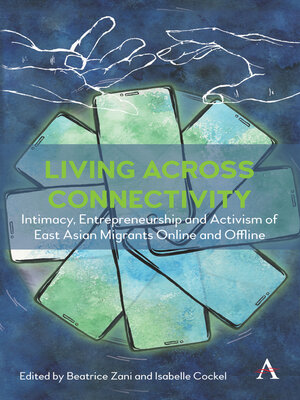Living across connectivity
ebook ∣ Intimacy, Entrepreneurship And Activism Of East Asian Migrants online and offline · Anthem Series on Global Migration in the Asia-Pacific Region
By Beatrice Zani

Sign up to save your library
With an OverDrive account, you can save your favorite libraries for at-a-glance information about availability. Find out more about OverDrive accounts.
Find this title in Libby, the library reading app by OverDrive.



Search for a digital library with this title
Title found at these libraries:
| Library Name | Distance |
|---|---|
| Loading... |
This volume fills a major gap in publications on migration and digital media worlds by bringing information and communication technology (ICT) to the fore of our understanding of migrants' experiences in, and practices of, connectivity and mobility. During recent decades, migration within and from East Asia has become paradigmatic of the changing substance and patterns of global mobility. Focusing on migration within and beyond East Asia, a region defined by its global migration and its leading role in ICT use and development, this volume explores the pervasive use of smartphones as an everyday reality for East Asian migrants, advocating the necessity of understanding how they live their lives both online and offline. In this respect, the originality of this volume lies in its interdisciplinary analysis of migrants' activities at the crossroads between physical and digital spaces. Our theoretical innovation and empirical findings will open an avenue to investigate the novel shape and scales of contemporary connectivity and mobility.
|The use of smartphones displays many facets of contemporary mobility. Smartphones and those applications downloaded to the device enhance connectivity in regard to socialisation, entertainment, transactions, networking, activism, and mobilisation. While the device and applications help community building and boost a sense of belonging, they also generate alienation, exclusion and marginalisation. Such online mobility of capital, commodity, idea and emotion visualised on smartphones cannot take place without the parallel existence of technological, sociopolitical and economic infrastructure that is established in the physical world offline. In this light, this book argues that the use of smartphones, and the constant switch between online and offline, has meshed virtual, social and physical mobilities together. However, such inseparability is yet to break down the boundary that marks their distinctive and discrete existence. Put simply, the absence, loss, outage, switch-off, unaffordability, or confiscation of the device can easily obstruct this meshed mobility. Interrogating what causes these obstructions will highlight the indispensable role played by the material and social infrastructure in this meshed mobility as well as the embedded structural constraints. It is equally important to look at migration and mobility beyond the points of departure and destination and trace the process in between, as scholarship in migration studies has advocated. Thus, this book offers an insight into the compression and tension between online and offline and the interlaced modes of mobility. On the whole, the articles included in this book aim to answer two critical questions: (1) How does the use of smartphones by migrants and the people connected with them generate new modes of mobility? (2) How do online activities and offline infrastructure interact and result in this compression?
In answering these two questions, the authors seek to understand how the online–offline divide and the shift between physical and virtual worlds affect East Asian migrants' activities. They investigate how these migrants' mobility patterns are changing through such compression and tension between online and offline. The book will show how smartphones and the associated applications facilitate the expression of emotions and search for intimate relationships, expedite the movement of capital and commodity, enable public communication and social action and solicit political allegiance to the state or political parties. This spontaneous mobility in the virtual space visualised on smartphones obscures the physical separation between origin and destination. It also...







